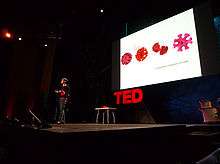Margaret Wertheim

Margaret Wertheim (born 1958, Brisbane, Australia) is a science writer and the author of books on the cultural history of physics.
Work
Wertheim is the author of three books that collectively consider the role of theoretical physics in the cultural landscape of modern Western society. The first, Pythagoras' Trousers, is a history of the relationship between physics, religion, and gender relations. The second, The Pearly Gates of Cyberspace, charts the history of scientific thinking about space from Dante to the Internet. The third book in this series, Physics on the Fringe, looks at the idiosyncratic world of "outsider physicists" such as Jim Carter, people with little or no scientific training who develop their own alternative theories of the universe.[1]
As a journalist, Wertheim has contributed to the New York Times and the Los Angeles Times and is a contributing editor to Cabinet magazine, the international arts and culture quarterly. From 2001 to 2005, she wrote the "Quark Soup" science column for the LA Weekly, sister paper to the Village Voice. In 2006, her writing was awarded the print journalism prize from the American Institute of Biological Sciences and, in 2004, she was the National Science Foundation visiting journalist to Antarctica. Her work was included in Best American Science Writing 2003, edited by Oliver Sacks.
Institute For Figuring
In 2003, Wertheim and her twin sister Christine founded the Institute For Figuring, an organization based in Los Angeles that promotes the public understanding of the poetic and aesthetic dimensions of science and mathematics. Christine Wertheim is a faculty member of the Department of Critical Studies at CalArts. Through their work with the IFF, the Wertheim twins have curated exhibitions on scientific and mathematical themes at art galleries and science museums around the world, including the Santa Monica Museum of Art, the Art Center College of Design, the Machine Project, the Museum of Jurassic Technology, the Science Gallery at Trinity College in Dublin, and the Smithsonian's National Museum of Natural History in Washington D.C. The IFF's "Hyperbolic Crochet Coral Reef" project is perhaps the biggest art and science community project in the world. More than 5000 people from New York and London, to Riga and Cape Town, have actively contributed pieces to Crochet Reef exhibitions. As of mid-2011, more than three million people have seen these shows. The "Hyperbolic Crochet Coral Reef" offers an intersection between mathematics, science, handicraft, environmentalism and community art practice.
Books
- Pythagoras' Trousers: God, Physics, and the Gender Wars (1995)
- The Pearly Gates of Cyberspace: A History of Space from Dante to the Internet (1999)
- A Field Guide to Hyperbolic Space (2005)
- A Field Guide to the Business Card Menger Sponge (2006)
- Physics on the Fringe: Smoke Rings, Circlons and Alternative Theories of Everything (2011)
References
- ↑ Jascha Hoffman, "Q&A: The outsider insider", Nature 11/3/2011, Vol. 479 Issue 7371, p40
External links
- Institute For Figuring — dedicated to aesthetic dimensions of science and mathematics
- Hyperbolic Crochet Coral Reef — international science+art project
- Wertheim's presentation at TED
- and a deeper discussion with TED editor Kari Mulholland
- Video of interview/discussion with Wertheim by George Johnson on Bloggingheads.tv
- The New York Times — Wertheim Op-Ed — Faster-than-light shadows
- LA Weekly - archived articles and columns
- Faith, Reason, Gender from Soka Gakkai International
- Wertheim article on women and science from The New York Times
- Wertheim article on quantum pseudo-mysticism from LA Weekly
- Wertheim Twins Crochet A Coral Reef from The Los Angeles Times